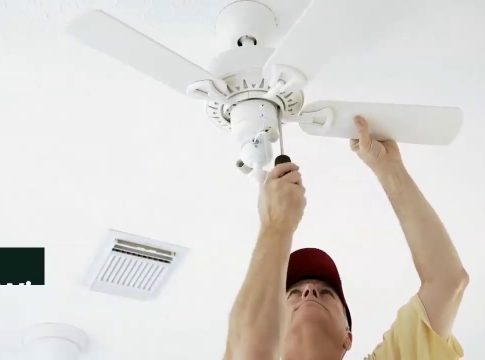Noisy ceiling fans are mostly caused by an imbalance of the fan blades, and the problem can be fixed easily as long as the culprit blade is discovered. This article will teach you how to fix a noisy ceiling fan. The problem in the fan blades can be because of:
- Manufacturing imperfections that can arise in any one of the blades installed in the same fan.
- An arm connected to the motor being bent during shipping.
- Even the properly balanced fans can wobble over time as the blades become loose.
These problems are the cause of noisy ceiling fans. Before you can start tooling around with the fan blades ensure that the cause of the problem is not due to faulty installation.
A fan should hang down from the ceiling, so if the fan is found to rest snugly against the ceiling the problem needs to be rectified. Sometimes the motor can be loose, and the fan still makes noise even when all the blades are taken off. This signs indicate that the fan needs thorough checks, which include;
- Pulling down the fan for checks before reinstallation.
- Noisy fans can be fixed by tightening the blade screws to fix loose blades. The fan is then put on to its highest speed too see if the noise problem has been eliminated.
- Persistent noise problems require that one measure the distance to the ceiling from the tip of each blade. Any blade higher or lower than the rest can be the cause of the noise.
The distance from the back to the front of each blade is measured to ensure all angles are the same.
Rebalancing is done quickly by using a rebalancing kit that can be acquired from local hardware stores. Before using the kit the fan needs to be turned on to determine the speed that causes the most noise. The fan is then switched off and the weighted clip from the kit placed on one of the blades and the fan switched on again. If the noise is still present the rebalancing process should be repeated for all the blades till the noise is eliminated. The weighted clip is placed on the blade requiring adjustment towards the motor. The clip is moved continually and testing done until the optimal placement is found. At that point an adhesive weight is placed, followed by removing the clip weight and turning on the fan. If the fan still makes noise the second adhesive weight is added. Tape coins can also be ducted to the blade instead of adhesive weights.
Noisy ceiling fans are mostly caused by an imbalance of the fan blades, and the problem can be fixed easily as long as the culprit blade is discovered. This article will teach you how to fix a noisy ceiling fan. The problem in the fan blades can be because of:
- Manufacturing imperfections that can arise in any one of the blades installed in the same fan.
- An arm connected to the motor being bent during shipping.
- Even the properly balanced fans can wobble over time as the blades become loose.
These problems are the cause of noisy ceiling fans. Before you can start tooling around with the fan blades ensure that the cause of the problem is not due to faulty installation.
A fan should hang down from the ceiling, so if the fan is found to rest snugly against the ceiling the problem needs to be rectified. Sometimes the motor can be loose, and the fan still makes noise even when all the blades are taken off. This signs indicate that the fan needs thorough checks, which include;
- Pulling down the fan for checks before reinstallation.
- Noisy fans can be fixed by tightening the blade screws to fix loose blades. The fan is then put on to its highest speed too see if the noise problem has been eliminated.
- Persistent noise problems require that one measure the distance to the ceiling from the tip of each blade. Any blade higher or lower than the rest can be the cause of the noise.
The distance from the back to the front of each blade is measured to ensure all angles are the same.
Rebalancing is done quickly by using a rebalancing kit that can be acquired from local hardware stores. Before using the kit the fan needs to be turned on to determine the speed that causes the most noise. The fan is then switched off and the weighted clip from the kit placed on one of the blades and the fan switched on again. If the noise is still present the rebalancing process should be repeated for all the blades till the noise is eliminated. The weighted clip is placed on the blade requiring adjustment towards the motor. The clip is moved continually and testing done until the optimal placement is found. At that point an adhesive weight is placed, followed by removing the clip weight and turning on the fan. If the fan still makes noise the second adhesive weight is added. Tape coins can also be ducted to the blade instead of adhesive weights.
